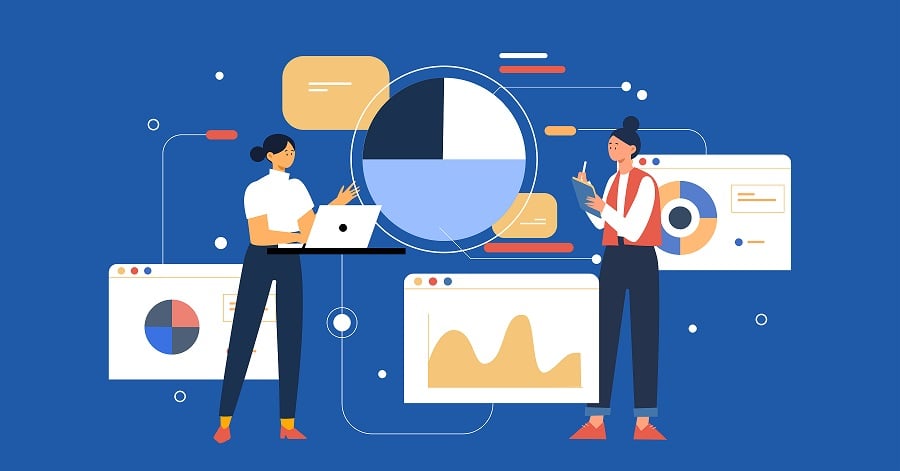The digital shelf is becoming increasingly important for brands, retailers and marketplaces as the share of our real-time economy that occurs online increases with every passing year. Statista estimates that eCommerce will make up over 20% of global retail sales by the end of 2022, a rate that has more than doubled over the last five years.
That means it’s never been more important to be smart and analytical about what’s going on at the digital shelf. It’s not enough to just have data; you need intelligence.
Wealth on the Shelf
Smart, comprehensive analytics isn’t just a nice-to-have feature, but an essential component of effective modern commerce. It brings critical benefits that brands need to compete in a mercurial marketplace.
| Efficiency | Measurement | The bottom line |
| The right information at the right time translates to more flexible and responsive processes. That means faster time-to-market, sharper responsiveness to competition, and less time wasted on low-value activities. | Meticulous tracking and timely reporting help you monitor trends, pinpoint weaknesses in your shopper experience, increase accountability within your organization, and attribute success to the right source. | Digital shelf analytics directly translates to meaningful impact on revenue growth. It empowers you to improve product discoverability, generate more opportunities to convert, and ultimately win every shelf. |
The 4 Pillars of Intelligent eCommerce Analytics
Smart product and content analytics are capable of drawing from broad swaths of different inputs and providing insights in related, but distinct, competencies.
Digital shelf analytics can be divided into four discrete categories that support and feed into each other, creating a funnel of eCommerce insights that lead to conversions and sales.

Operational Intelligence
This category of insights and data primarily concerns the more tangible, practical side of running and managing eCommerce. It includes factors like:
- Real-time stock status and inventory availability by geographic location
- Big-picture pricing of all products within a category
- How dynamic and promotional pricing influences add-to-cart rates
- The proportion of buy boxes your products own and win
- Digital advertising in your markets and how it shapes the product search page
- Monitoring first movers within specific markets and verticals
Content Intelligence
Content intelligence covers factors related to the product information and assets a brand shares with a retailer and what shoppers can see and experience on a product description page. It features:
- Evaluating the quality and depth of product content and how well it meets the expectations of retailers and consumers
- Ensuring information and imagery are correct, up-to-date, and consistent across platforms
- Where product content is in the process of getting shared, reviewed, and published
- Comparing what information and assets you syndicate to a retailer vs what actually appears on the product page
- Identifying product content gaps in conditions and requirements set by retailers and marketplaces
Marketing Intelligence
This category encompasses all data and inputs relating to on-site discoverability and the interactions customers are having with your products online.
- Where your brand and competitors rank for certain search terms on a given eCommerce site, and how much of the paid and organic digital shelf you occupy
- Ratings, reviews, and feedback on a product left by customers
- The words and phrases that are most often associated with your products
- The influence rich content and multimedia experiences have on shopper engagement
Shopper Intelligence
The final school of digital shelf analytics covers how shoppers behave after visiting your product description pages and viewing your content. This includes some critical data points:
- How often shoppers go on to convert and purchase
- How shoppers use enhanced content like contextual hotspots, interactive toolbars, or comparison charts on your product pages
- How long shoppers watch video content and when they tend to drop off from viewing
Learn more: See how these four disciplines work together to influence the online customer journey.












If I Only Had a Brain
Any knowledge is only as good as the mind that’s using it.
It’s not uncommon for brands to have vast pools of data and reporting technology. But often those resources sit gathering dust in siloed databases, not coming together to offer crucial context. They provide information, but not insight.
You need a brain to compare, validate, and connect the inputs feeding your eCommerce intel and translate them into a digestible, KPI-focused format.
When operational, content, marketing and shopper intelligence all come together, you have the perfect recipe to dominate the digital shelf and generate a fully optimized product content experience for customers.
Syndigo is the only solution that can seamlessly ingest, manage, and display critical data from every aspect of digital shelf analytics all in one place. Our two-sided retail network keeps data and content constantly flowing to and from product pages, retail partners, and consumers to give you a complete and timely picture of what’s working across the eCommerce ecosystem. With Syndigo’s analytics and reporting capabilities, it’s easy to understand product and site performance at a much deeper level and raise your brand’s eCommerce IQ.










